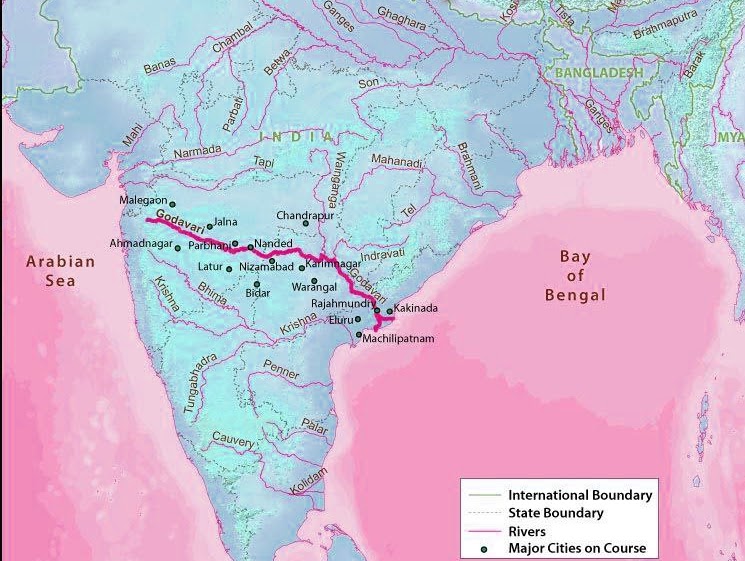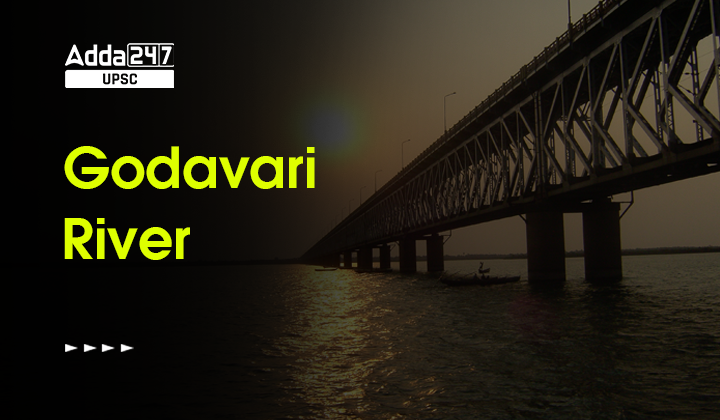Table of Contents
The Godavari River is one of the major rivers of India, originating from the Trimbakeshwar Temple in the Nashik district of Maharashtra. It is the second-longest river in India after the Ganges and flows through several states including Maharashtra, Telangana, Andhra Pradesh, Chhattisgarh, and Odisha before emptying into the Bay of Bengal.
The river is often referred to as the “Dakshin Ganga” or the “South Ganges” due to its religious significance and cultural importance in South India. The Godavari river basin is also known for its rich biodiversity and is home to several species of flora and fauna, including the endangered Mugger crocodile and the Ganges river dolphin.
Godavari River Map
The map will show the course of the river as it flows through various states in India, including Maharashtra, Telangana, Andhra Pradesh, Chhattisgarh, and Odisha, and ultimately emptying into the Bay of Bengal. The Godavari River is a major river in India and its basin covers an area of about 312,812 square kilometers.

Godavari River Origin
The Godavari River originates from the Brahmagiri mountain range in the Trimbakeshwar Temple area of Nashik district in Maharashtra, India. The river emerges from the Brahmagiri hills in the Western Ghats at an elevation of 1,067 meters above sea level.
The exact spot where the river originates is known as the “Gangadwar” or “Gangasagar” and is considered to be a sacred site by Hindus. The river then flows eastward for over 1,450 kilometers through various states of India before emptying into the Bay of Bengal. The Godavari River is the second-longest river in India after the Ganges and is an important source of water for irrigation, drinking, and industrial purposes in the region.
Godavari River Length
The Godavari River is the second-longest river in India after the Ganges, with a total length of approximately 1,465 kilometers. The river originates from the Brahmagiri mountain range in the Nashik district of Maharashtra and flows eastward through various states including Maharashtra, Telangana, Andhra Pradesh, Chhattisgarh, and Odisha before draining into the Bay of Bengal.
The Godavari River has an extensive river basin covering an area of about 312,812 square kilometers and is an important source of water for irrigation, drinking, and industrial purposes in the region. The river also plays a significant role in the religious and cultural life of people living in the areas it flows through.
Origin of Godavari River
The Godavari River originates from the Brahmagiri mountain range in the Nashik district of Maharashtra, India. The river emerges from the Brahmagiri hills in the Western Ghats at an elevation of 1,067 meters above sea level. The exact spot where the river originates is known as the “Gangadwar” or “Gangasagar” and is considered to be a sacred site by Hindus.
The Godavari River then flows eastward for over 1,450 kilometers through various states of India before draining into the Bay of Bengal. The river is the second-longest river in India after the Ganges and is an important source of water for irrigation, drinking, and industrial purposes in the region. It also plays a significant role in the religious and cultural life of people living in the areas it flows through.
Godavari River Tributaries
- Pranhita River: It is the largest tributary of the Godavari River and originates in the Chhattisgarh state. It merges with the Godavari River near the town of Kaleshwaram in Telangana.
- Indravati River: It originates in the Kalahandi district of Odisha and flows through the state of Chhattisgarh before merging with the Godavari River in the Bhadrachalam district of Telangana.
- Sabari River: It originates in the Eastern Ghats in the state of Odisha and flows through the states of Chhattisgarh and Telangana before merging with the Godavari River in the state of Andhra Pradesh.
- Wardha River: It is a major tributary of the Godavari River and originates in the state of Maharashtra. It merges with the Godavari River in the state of Telangana.
- Wainganga River: It originates in the state of Maharashtra and flows through the states of Madhya Pradesh and Chhattisgarh before merging with the Godavari River in the state of Maharashtra.
Ques. Where does the Godavari River originate?
Ans. The Godavari River originates from the Brahmagiri mountain range in the Nashik district of Maharashtra, India.
Ques. How long is the Godavari River?
Ans. The Godavari River is the second-longest river in India after the Ganges, with a total length of approximately 1,465 kilometers.
Ques. What are some of the major tributaries of the Godavari River?
Ans. Some of the major tributaries of the Godavari River include the Pranhita River, Indravati River, Sabari River, Wardha River, and Wainganga River.
Ques. What is the importance of the Godavari River?
Ans. The Godavari River is an important source of water for irrigation, drinking, and industrial purposes in the region. It also plays a significant role in the religious and cultural life of people living in the areas it flows through.
Ques. Which states does the Godavari River flow through?
Ans. The Godavari River flows through the states of Maharashtra, Telangana, Andhra Pradesh, Chhattisgarh, and Odisha before draining into the Bay of Bengal.
Ques. Is the Godavari River used for transportation?
Ans. In the past, the Godavari River was used for the transportation of goods and people through boats and steamers. However, with the advent of modern transport systems, the river is no longer a major means of transportation.
Ques. What is the significance of the Godavari Pushkaram festival?
Ans. The Godavari Pushkaram is a festival that occurs once every 12 years and is celebrated in honor of the Godavari River. It is considered to be a major religious and cultural event and attracts a large number of devotees from all over the country.
Ques. Is the Godavari River prone to floods?
Ans. Yes, the Godavari River is prone to floods during the monsoon season due to heavy rainfall and other factors. Floods can cause damage to property and infrastructure and affect the livelihoods of people living in the affected areas. Efforts are being made to mitigate the impact of floods through various measures including the building of dams and other structures.



 TSPSC Group 1 Question Paper 2024, Downl...
TSPSC Group 1 Question Paper 2024, Downl...
 TSPSC Group 1 Answer key 2024 Out, Downl...
TSPSC Group 1 Answer key 2024 Out, Downl...
 UPSC Prelims 2024 Question Paper, Downlo...
UPSC Prelims 2024 Question Paper, Downlo...





